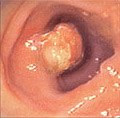Colonic polyp
| Colonic polyp | |
|---|---|
| Colonic polyp | |
| ICD-9 | V12.72 |
| OMIM | 175100 |
| MeSH | D003111 |
In medicine, colonic polyps are "discrete tissue masses that protrude into the lumen of the colon. These polyps are connected to the wall of the colon either by a stalk, pedunculus, or by a broad base."[1]
Classification
Hyperplastic polpys
Adenomatous polyps
Adenomatous colonic polyps are common and are present in 25% of men and 15% of women undergoing screening colonoscopy.[2]
- Tubular adenomas
- Tubulovillous adenomas
- Villous adenomas
Prognosis
| Polyp size | Cancer % |
Villous histology or high-grade dysplasia % |
Total % |
|---|---|---|---|
| < 4 mm | < 0.5 | < 2 | < 2 |
| 5–10 mm | < 1 | 9 | 10 |
Adenomatous colonic polyps may progress to colorectal cancer; however, less than 10% do so.[2]
High risk colonic polyps are defined as either:[4]
- 3 or more synchronous adenomas
- adenomas ≥1 cm in diameter
- villous histology or high-grade dysplasia
The risk of dysplasia depends on the size of the polyp:[3]
Screening
A clinical practice guideline jointly written by the American Cancer Society and other groups recommends one of:[5]
- Flexible sigmoidoscopy every 5 years
- Barium enema every 5 years
- Virtual colonography (a noninvasive test based on computed tomography) every 5 years
- Colonoscopy every 10 years
When polyps are found, a clinical practice guideline jointly written by the American Cancer Society and other groups states:[4]
- High risk polyps are 1) 3 or more synchronous adenomas, 2) adenomas ≥1 cm in diameter, or 3) villous histology or high-grade dysplasia.
- High risk polyps should have follow-up colonoscopy in 3 years
- Low risk polyps should have repeat colonoscopy in 5 to 10 years
- If no adenomas are found, follow-up evaluation should be at 10 years
A validation of these guidelines found:[6]
- High risk adenomas - 9% of an advanced adenoma at 4 years of follow-up.
- Low risk adenomas - 5% of an advanced adenoma at 4 years of follow-up.
References
- ↑ Anonymous (2024), Colonic polyp (English). Medical Subject Headings. U.S. National Library of Medicine.
- ↑ 2.0 2.1 Levine JS, Ahnen DJ (December 2006). "Clinical practice. Adenomatous polyps of the colon". The New England journal of medicine 355 (24): 2551–7. DOI:10.1056/NEJMcp063038. PMID 17167138. Research Blogging.
- ↑ 3.0 3.1 Butterly LF, Chase MP, Pohl H, Fiarman GS (March 2006). "Prevalence of clinically important histology in small adenomas". Clinical gastroenterology and hepatology : the official clinical practice journal of the American Gastroenterological Association 4 (3): 343–8. DOI:10.1016/j.cgh.2005.12.021. PMID 16527698. Research Blogging.
- ↑ 4.0 4.1 Winawer SJ, Zauber AG, Fletcher RH, et al (May 2006). "Guidelines for colonoscopy surveillance after polypectomy: a consensus update by the US Multi-Society Task Force on Colorectal Cancer and the American Cancer Society". Gastroenterology 130 (6): 1872–85. DOI:10.1053/j.gastro.2006.03.012. PMID 16697750. Research Blogging.
- ↑ Levin, B., Lieberman, D. A., McFarland, B., Smith, R. A., Brooks, D., Andrews, K. S., et al. (2008). Screening and surveillance for the early detection of colorectal cancer and adenomatous polyps, 2008: a joint guideline from the American Cancer Society, the US Multi-society Task Force on Colorectal Cancer, and the American College of Radiology. CA Cancer J Clin, CA.2007.0018. DOI:10.3322/CA.2007.0018.
- ↑ Laiyemo AO, Murphy G, Albert PS, et al (March 2008). "Postpolypectomy colonoscopy surveillance guidelines: predictive accuracy for advanced adenoma at 4 years". Ann. Intern. Med. 148 (6): 419–26. PMID 18347350. [e]
